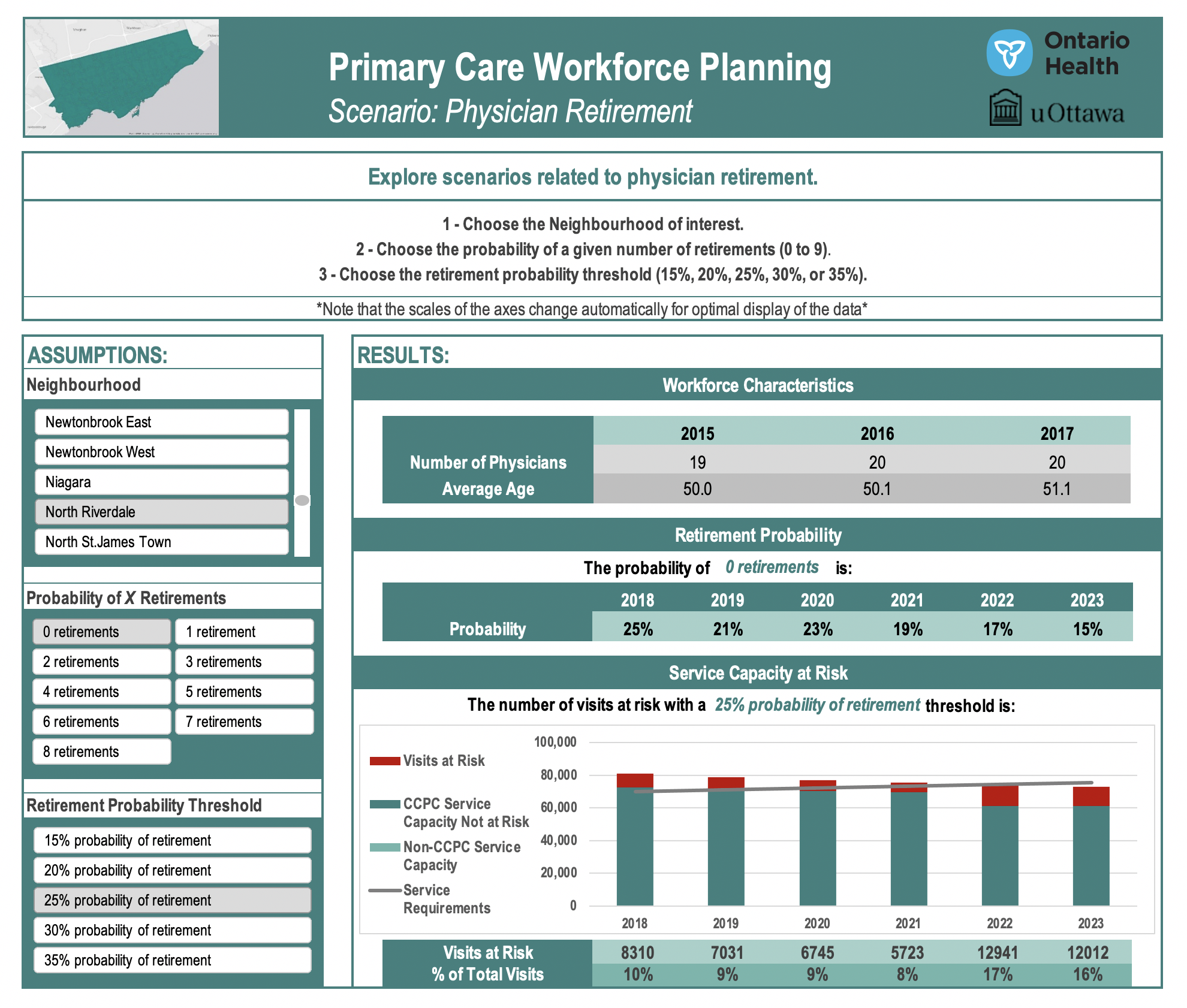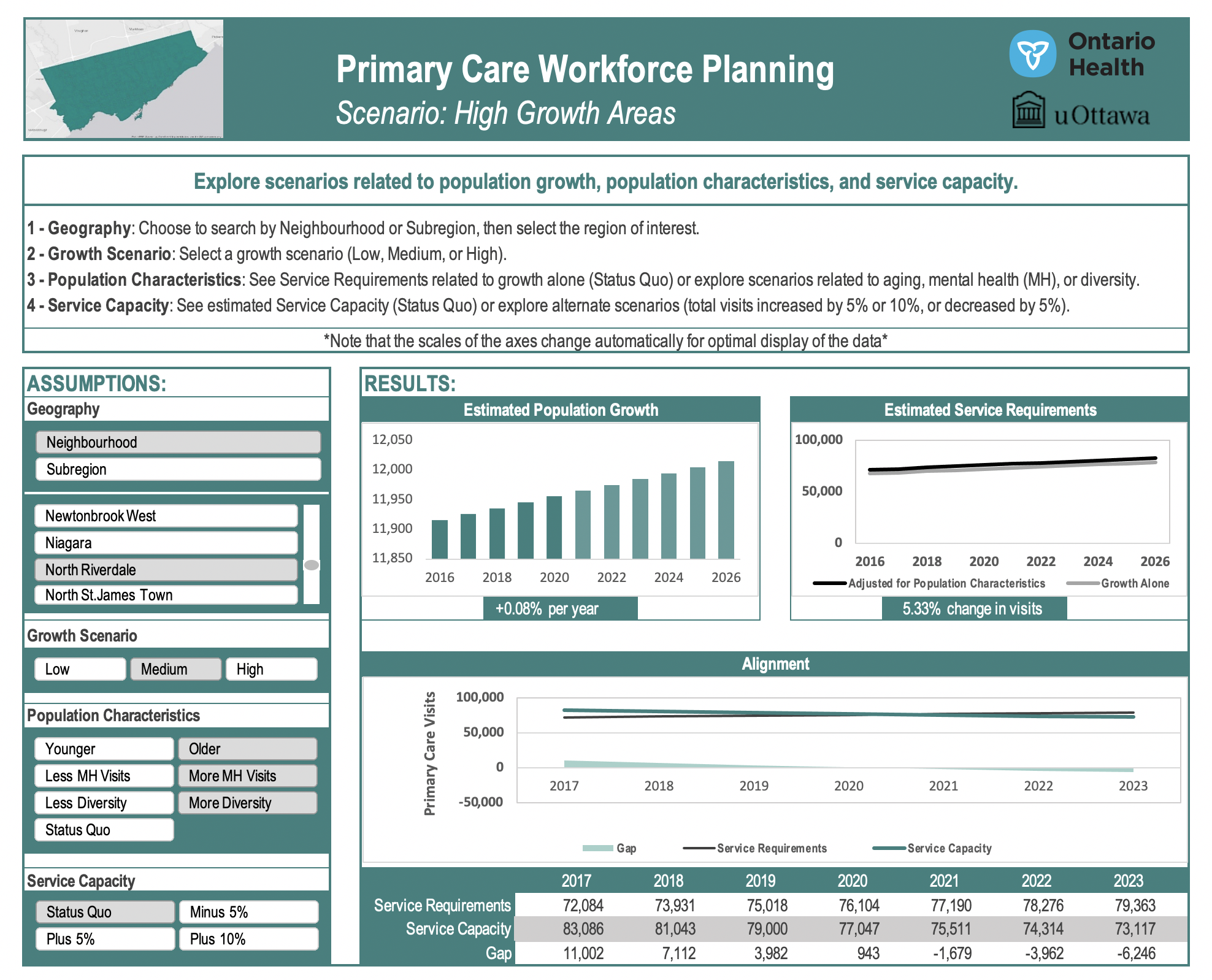Toronto Region Primary Care Workforce Planning Toolkit
 The Canadian Health Workforce Network is a knowledge exchange network of researchers, decision-makers, and other knowledge users interested in health workforce planning, policy and management.
Our mission is to be the Canadian source of health workforce information, making it accessible and useful in support of better health system decision-making. Our vision is: open, transparent and evidence-informed health workforce decision-making supporting workers, patients and health systems.
The Canadian Health Workforce Network is a knowledge exchange network of researchers, decision-makers, and other knowledge users interested in health workforce planning, policy and management.
Our mission is to be the Canadian source of health workforce information, making it accessible and useful in support of better health system decision-making. Our vision is: open, transparent and evidence-informed health workforce decision-making supporting workers, patients and health systems.
PROJECT DESCRIPTION
The Toronto Region Primary Care Workforce Planning Toolkit is a fit-for-purpose toolkit to support integrated primary care workforce planning in the Toronto Region. The toolkit is the result of a collaboration between the Health Analytics team at Ontario Health Toronto and consultants from the Canadian Health Workforce Network. A partnership with the City of Toronto, as well as extensive consultation with stakeholders, decision-makers, leaders, and frontline workers in Toronto, informed the development of the toolkit.
The toolkit provides a body of evidence around the current (and projected future) states of population health needs and primary care service provision at a neighbourhood level within the City of Toronto. The goal of the toolkit is to support evidence-based decision-making, particularly with regards to deployment of the primary care workforce and other health system resources. The toolkit looks at population needs and workforce capacity at the neighbourhood, sub-region, and whole city levels. It takes into account variations in population needs, workforce service capacity, and existing assets, and also addresses challenges specific to Toronto, such as patient mobility, anticipated rapid population growth, and physician retirement.
This toolkit will help providers, planners, stakeholders, and Ontario Health Teams:
- Understand more about the patients they are serving, where they come from, and their primary care needs;
- Estimate the primary care resources (MDs, NPs, allied health professions) needed for their patients;
- Identify future emerging needs that could be addressed by OHTs, taking into account population growth, demographic shifts, provider retirement, and changing practice patterns; and
- Inform strategies to transform care by testing a range of relevant scenarios.
CITY PROFILE
The City Profile package is a collection of city-level outputs that includes a synthesis of information about alignment between physician service requirements and service capacity, population health profiles, estimated population growth, spatial patterns of utilization, Ontario Marginalization Index scores, indicators of unmet need for primary care, and a profile of the primary care workforce in the city.
The package also includes maps that show estimated growth rates, numbers of physicians and primary care visits required and provided in each neighbourhood, and the gap between service requirements and service capacity.
A series of maps that capture spatial patterns of utilization, as well as maps showing the outputs of retirement modelling, are also included in the package.
Download the City Profile
SUB-REGION AND NEIGHBOURHOOD PROFILES

|
Read more here.
The Neighbourhood Profile provides users with a snapshot of the primary care landscape in each neighbourhood. These profiles include information about alignment between physician service requirements and service capacity, the age distribution of residents and the prevalence of key health conditions, estimated population growth, spatial patterns of utilization, Ontario Marginalization Index scores, indicators of unmet need for primary care, and a profile of the primary care workforce in the neighbourhood.
SUB-REGION PROFILES Use the tabs below to locate the Sub-Region of interest. Navigate to the neighbourhood of interest and download the profile package. Alternatively, access the profile packages for all neighbourhoods in the Sub-Region by downloading the Sub-Region Synthesis file. |

| Neighbourhood Number | Neighbourhood Name | Available Profiles |
|---|---|---|---|
| 32 | Englemount-Lawrence | Englemount-Lawrence | |
| 39 | Bedford Park-Nortown | Bedford Park-Nortown | |
| 41 | Bridle Path-Sunnybrook-York Mills | Bridle Path-Sunnybrook-York Mills | |
| 56 | Leaside-Bennington | Leaside-Bennington | |
| 97 | Yonge-St.Clair | Yonge-St.Clair | |
| 99 | Mount Pleasant East | Mount Pleasant East | |
| 100 | Yonge-Eglinton | Yonge-Eglinton | |
| 101 | Forest Hill South | Forest Hill South | |
| 102 | Forest Hill North | Forest Hill North | |
| 103 | Lawrence Park South | Lawrence Park South | |
| 104 | Mount Pleasant West | Mount Pleasant West | |
| 105 | Lawrence Park North | Lawrence Park North | |
| 106 | Humewood-Cedarvale | Humewood-Cedarvale | |
| Sub-Region 703 – North Toronto | Sub-Region 703 – North Toronto | ||
INTERACTIVE RETIREMENT SCENARIO DASHBOARD
 The INTERACTIVE RETIREMENT SCENARIO DASHBOARD is Coming soon
The INTERACTIVE RETIREMENT SCENARIO DASHBOARD is Coming soon
The Interactive Retirement Scenario Dashboard is a tool that can be used to explore different physician retirement scenarios that are relevant to primary care planning and decision-making.
Information elements in the dashboard include physician workforce characteristics, the probability of 0 to 9 retirements from 2018 to 2023, and service capacity at risk of loss due to retirement under five retirement scenarios.
Scenarios take into account the age structure of the physician workforce, age-related retirement probabilities, and age-related changes in service capacity.
Once neighbourhoods with populations at risk of being underserved due to physician retirement have been identified, planning can take place to mitigate the impact of retirement.
For information or for a virtual data session for the INTERACTIVE RETIREMENT SCENARIO DASHBOARD contact the Health Analytics team at Ontario Health Toronto:
OH Toronto Health Analytics
OH-TorontoHealthAnalytics@ontariohealth.ca
OH Toronto Health Analytics
OH-TorontoHealthAnalytics@ontariohealth.ca
INTERACTIVE POPULATION GROWTH SCENARIO DASHBOARD
 The INTERACTIVE POPULATION GROWTH SCENARIO DASHBOARD is Coming soon
The INTERACTIVE POPULATION GROWTH SCENARIO DASHBOARD is Coming soon
The Interactive Population Growth Dashboard is a tool that can be used to explore 84 different scenarios that are relevant to primary care planning and decision-making. Information elements in the dashboard include anticipated population growth, estimated service requirements, and alignment of service requirements and service capacity over time. The tool can be used to explore what happens to alignment when population characteristics and/or workforce capacity change. Once neighbourhoods with populations at risk of being underserved due to rapid population growth have been identified, planning can take place to ensure that appropriate resources are available.
For information or for a virtual data session for the INTERACTIVE POPULATION GROWTH SCENARIO DASHBOARD contact the Health Analytics team at Ontario Health Toronto:
OH Toronto Health Analytics
OH-TorontoHealthAnalytics@ontariohealth.ca
OH Toronto Health Analytics
OH-TorontoHealthAnalytics@ontariohealth.ca
FINAL REPORT
The final report is a slide deck that summarizes the process, inputs, outputs, and impact of the project.
Download the Final Report
USER GUIDE
The different outputs of this toolkit build on each other to provide a comprehensive overview of primary care workforce needs. The User Guide outlines the steps to undertake when conducting this type of analysis.
Download the User Guide
TECHNICAL NOTES
MORE INFORMATION
TOOLKIT ON THE CANADIAN HEALTH WORKFORCE NETWORK WEBSITE
For more information about health workforce planning and the tools used in this planning exercise, please visit
www.hhr-rhs.ca
Implementing leading practices in regional-level primary care workforce planning: Lessons learned in Toronto
Sarah Simkin, Caroline Chamberland-Rowe, Cynthia Damba, Nathalie Sava, Ting Lim and Ivy Lynn Bourgeault
https://journals.sagepub.com/doi/full/10.1177/08404704221117263
Co-developing an integrated primary care workforce planning approach at a regional level: overarching framework and guiding principles
Ivy Lynn Bourgeault, Caroline Chamberland-Rowe and Sarah Simkin
https://human-resources-health.biomedcentral.com/articles/10.1186/s12960-021-00578-z
An integrated primary care workforce planning toolkit at the regional level (part 1): qualitative tools compiled for decision-makers in Toronto, Canada
Caroline Chamberland-Rowe, Sarah Simkin and Ivy Lynn Bourgeault
https://human-resources-health.biomedcentral.com/articles/10.1186/s12960-021-00610-2
An integrated primary care workforce planning toolkit at the regional level (part 2): quantitative tools compiled for decision-makers in Toronto, Canada
Sarah Simkin, Caroline Chamberland-Rowe and Ivy Lynn Bourgeault
https://human-resources-health.biomedcentral.com/articles/10.1186/s12960-021-00595-y
Canadian Health Workforce Network Webinar (December 2020)
Integrated Primary Health Workforce Planning in the City of Toronto: Inputs, Process, Outputs and Impact
https://www.youtube.com/watch?v=WulX3QeKA2Q
For more information about health workforce planning and the tools used in this planning exercise, please visit
www.hhr-rhs.ca
Sarah Simkin, Caroline Chamberland-Rowe, Cynthia Damba, Nathalie Sava, Ting Lim and Ivy Lynn Bourgeault
https://journals.sagepub.com/doi/full/10.1177/08404704221117263
Ivy Lynn Bourgeault, Caroline Chamberland-Rowe and Sarah Simkin
https://human-resources-health.biomedcentral.com/articles/10.1186/s12960-021-00578-z
Caroline Chamberland-Rowe, Sarah Simkin and Ivy Lynn Bourgeault
https://human-resources-health.biomedcentral.com/articles/10.1186/s12960-021-00610-2
Sarah Simkin, Caroline Chamberland-Rowe and Ivy Lynn Bourgeault
https://human-resources-health.biomedcentral.com/articles/10.1186/s12960-021-00595-y
Integrated Primary Health Workforce Planning in the City of Toronto: Inputs, Process, Outputs and Impact
https://www.youtube.com/watch?v=WulX3QeKA2Q
